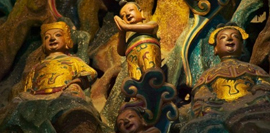Lion's head is a dish from the Huaiyang cuisine of eastern China, consisting of large pork meatballs (about 7–10 cm in diameter) stewed with vegetables.

The name derives from the shape of the meatball which is supposed to resemble the head of the lion and the cabbage (or other vegetables), which is supposed to resemble the lion's mane.
There are two varieties: the white (or plain), and the red (cooked with soy sauce). The plain variety is usually stewed or steamed with napa cabbage. The red variety can be stewed with cabbage or cooked with bamboo shoots and tofu derivatives. The minced meat in the meatball tends to be made from fatty pork (lean pork making for a less desirable taste), often with some chopped water chestnut for textural variation.
The dish originated in the region of Yangzhou and Zhenjiang in Jiangsu province, with the plain variety more common in Yangzhou and the red variety more common in Zhenjiang. The dish became a part of Shanghai cuisine with the influx of migrants in the 19th and early 20th century.
In Northern China, especially in Beijing, the dish is known as "Sixi Wanzi" ("Four Happy Balls") because the meatballs are usually served in a set of four. These meatballs tend to be smaller than the Southern variety.






